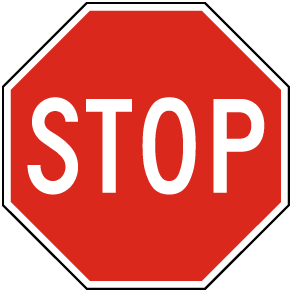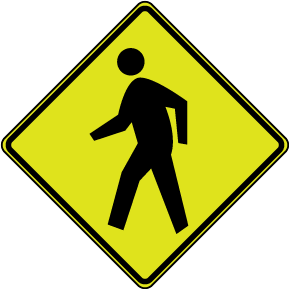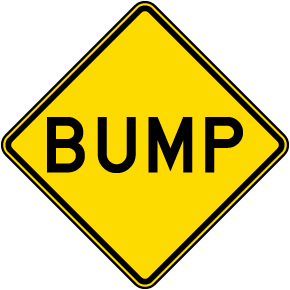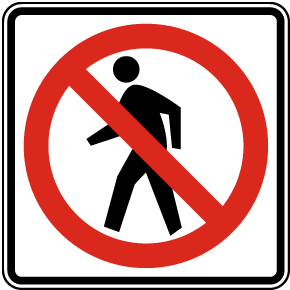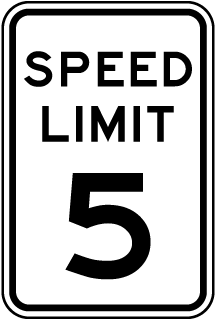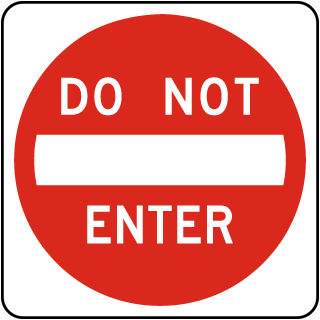Traffic Signs and Their Meanings
Understanding the Different Types of Traffic Signs and What They Mean
Understanding the different types of traffic signs and their meanings is key for safety on the road; both as a pedestrian and a driver. There is a large variety of road signs you might encounter while driving, and familiarizing yourself with the differences between them will help you make safe decisions faster and with ease. Whether you’re an experienced driver or are studying for your driver’s education exam, we encourage everyone to take a few moments and know the basic types of traffic signs.
Each type of sign you encounter on the road serves a purpose. Let’s take a look at what these types of signs are, and how they are implemented on the road.
Regulatory signs (white or red background)
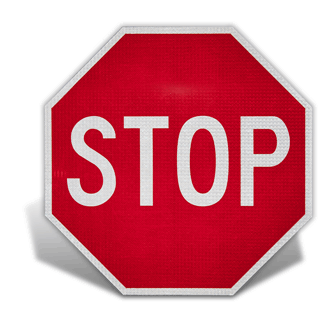
Regulatory road signs are an important type of traffic sign to know, as they establish rules and regulations that all road users must adhere to. Regulatory signs serve as explicit directives that specify speed limits, parking restrictions, and other mandatory rules essential for maintaining order and safety on the road.
Most regulatory signs have a white background, however, some regulatory signs such as stop signs and yield signs have a red background. Regulatory signs with a red background will have a white legend, and those with a white background will have a red or black legend, or a combination of the two.
Here are a few common examples of regulatory signs:
- Stop Signs (MUTCD Sign Designation Code R1-1): Stop signs are regulatory road signs that serve the crucial purpose of instructing drivers to come to a complete stop at an intersection or before crossing a designated point on the road. Their primary function is to control traffic flow and ensure safety at potentially hazardous or busy areas.
- Speed Limit Signs (MUTCD Sign Designation Code R2-1): Speed limit signs play an important role in ensuring roadway safety. These regulatory signs establish the maximum allowable speed for vehicles within specific areas, creating a balance between efficient mobility and accident prevention.
Shop all regulatory road signs.
Warning signs (yellow background)
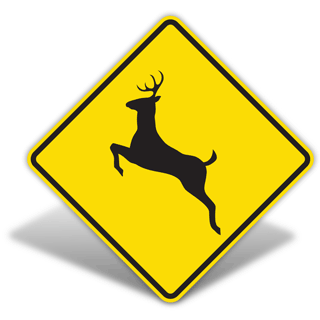
Warning signs are an essential category of road signs designed to inform drivers and other road users of potential hazards, dangers, or changes in road conditions. The primary purpose of warning signs is to provide advance notice and encourage caution, so that drivers can take appropriate steps to avoid accidents or navigate challenges safely.
Regulatory road signs are typically characterized by their distinctive yellow background and black symbols or text. They are also commonly made in diamond shapes, which helps to catch the attention of drivers and ensure they're warned of any upcoming hazards.
Some common warning sign examples include:
- Chevron Alignment Sign (MUTCD W1-8): Chevron alignment signs are road signs used to indicate a sharp change in the direction of the road, such as a curve or bend. A distinctive chevron-shaped arrow points in the direction of the upcoming curve, providing advanced warning to drivers to help them navigate the road safely, reducing the risk of an accident.
- Deer Crossing Sign (MUTCD W11-3): Deer crossing signs are placed on roadways in areas with high deer populations. These signs alert drivers to the potential presence of deer crossing the road, prompting them to exercise caution and be prepared to slow down or stop to avoid collisions with these unpredictable wildlife animals.
Shop all warning and road hazard signs.
Guide signs (green, blue, or brown background)
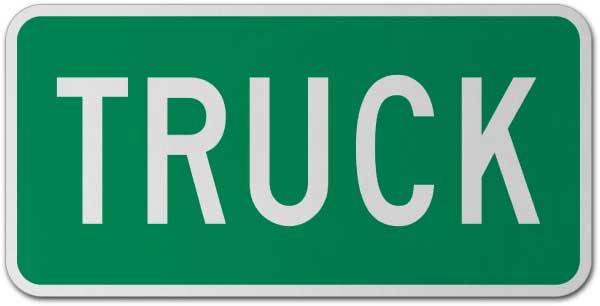
Guide signs are a category of traffic signs that provide valuable information to drivers to help them get around safely and efficiently. They offer information about destinations, distances, and directions, guiding motorists to specific locations such as cities, tourist attractions, and services. Additionally, guide signs may include exit numbers and route markers, aiding travelers in making informed choices and staying on the right path.
These signs typically have green backgrounds with white legends, but can also be found with blue or brown backgrounds. These signs are most commonly seen along interstates and highways, especially near exits or junctions.
Here are a few common examples of guide sign examples:
- East Route Marker Sign (MUTCD M3-2): East route marker signs serve as directional indicators to guide road users along a specific route or highway heading east. These signs are instrumental in helping drivers maintain their desired course and stay oriented as they navigate roadways. Other cardinal direction signs can be utilized to indicate other directions, such as North, South, and West.
- Truck Route Marker Sign (MUTCD M4-4): Truck route marker signs are designed to indicate roads and routes suitable for trucks. These signs are instrumental in guiding commercial truck traffic away from roads with weight or size restrictions, helping to reduce accidents/damage and ensure the safety of all road users.
Shop all guidance and information signs.
Service and recreation signs (blue, brown, or white background)
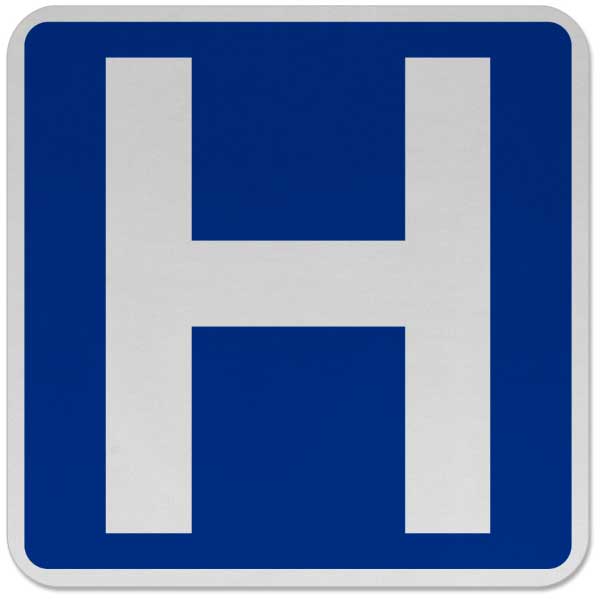
Service and recreation signs are designed to inform travelers about nearby services and recreational facilities. They guide motorists to essential amenities like gas stations, rest areas, food, and lodging options, ensuring that drivers can make timely and informed stops during their journeys.
Similar to guide signs, these signs typically feature white legends on blue, brown backgrounds. In some cases, such as directional parking signs, the background of the sign is white and the legend is green.
Some common examples of service and recreational signs include:
- Parking Area Sign (Diagonal Arrow): Parking are signs are helpful tools to indicate the direction in which parking is found in a specific area. The diagonal arrow helps drivers easily find the permitted parking direction causing less confusion and easier navigation.
- Hospital Sign: Hospital signs are helpful tools designed to guide individuals to healthcare facilities. These signs often feature the universal "H" symbol and/or directional arrows, ensuring that patients, visitors, and emergency services personnel can easily locate hospitals in emergency situations or when seeking medical services.
Shop all service and recreation signs.
Temporary traffic control (orange background)
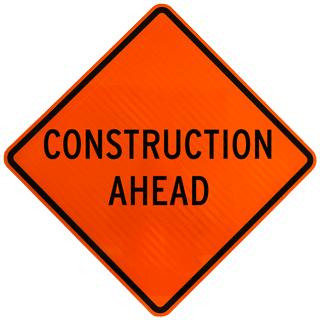
Temporary traffic control signs are used in a variety of settings. These signs play an important role in managing and redirecting traffic during road construction, maintenance work, or special events. They can provide information on detours, speed limits, lane closures, and any other temporary conditions.
Temporary traffic control signs are helpful for minimizing confusion and potential hazards. Since adhering to these signs is critical for safety, they are generally orange in color to stand out and grab the attention of road users, especially in construction zones.
Some common examples of temporary traffic control signs include:
- One Lane Bridge Sign: One lane bridge signs are usually displayed to alert drivers to upcoming single-lane bridges. These signs prepare motorists for reduced traffic capacity and navigating the right-of-way on a bridge.
- Divided Highway Sign: Divided highway signs are crucial for informing drivers that they are approaching or entering a section of road with a physical barrier, such as a median or barrier, separating the opposing lanes of traffic.
Shop all temporary traffic control signs.
Incident management signs (pink/coral background)
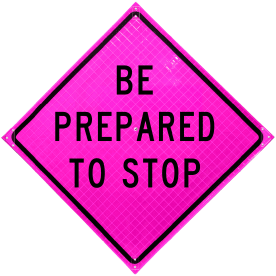
Incident management signs (commonly referred to as pink road signs) are designed to manage and mitigate the impact of emergencies, accidents, and other unforeseen incidents on roadways. They provide crucial information on detours, road closures, and alternative routes, helping to provide efficient emergency response and management of incidents.
Pink road signs are typically made with a bright pink background and black legend to ensure high visibility. These signs utilize a diamond shape that alert drivers to special road hazards, such as temporary detours, road closures, flooding, and more.
Some common examples of incident management signs include:
- Be Prepared To Stop Pink Roll-Up Sign (MUTCD W3-4): This sign is commonly used in temporary traffic control situations, such as construction zones, to warn drivers of upcoming road conditions that may require them to come to stop. Its vibrant color is meant to grab a driver’s attention and encourage them to exercise caution, reduce speed, and be ready for potential traffic congestion or unexpected stops ahead.
- Exit Closed (MUTCD E5-2a): The exit closed incident management sign is specifically used to indicate the closure of an exit on the roadway. This sign is a helpful tool for alerting drivers to the unavailability of a particular exit, prompting them to seek an alternative route and avoid congestion or delays caused by the exit's closure.
Shop all incident management signs.
Pedestrian and bicycle signs (many background colors)
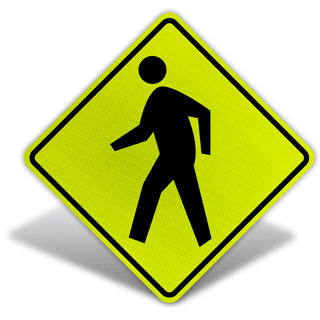
Pedestrian and bicycle signs are designed to enhance the safety of both bicyclists and pedestrians on the road. These include, but are not limited to, pedestrian crossing signs, bicycle crossing signs, yield to pedestrian signs, playground signs, school crosswalk signs, and bike lane signs. These signs provide clear directives for both drivers and other road users to guide them while sharing the roadway.
Pedestrian and bicycle signs utilize several different colored backgrounds because they can serve a wide range of purposes. They also utilize different shapes, depending on if the sign is meant as a warning, traffic regulation, or guide.
Some common examples of pedestrian and bicycle signs include:
- Bicycle & Pedestrian Crossing Sign: Bicycle and pedestrian crossing signs are designed to enhance the safety of both cyclists and pedestrians at designated crossing points.
- Share The Road Sign: Share the road signs are a crucial part of traffic management, promoting the safe coexistence of different road users. These signs typically feature symbols of bicycles, pedestrians, or other non-motorized forms of transportation that help remind everyone to be attentive, patient, and respectful when sharing the road.
Check out all of our bicycle signs and pedestrian signs.
Different types of signs all serve their own purposes. Knowing the various kinds of signs can help all road users navigate all scenarios with confidence and ease. Here are some helpful links for further information:

